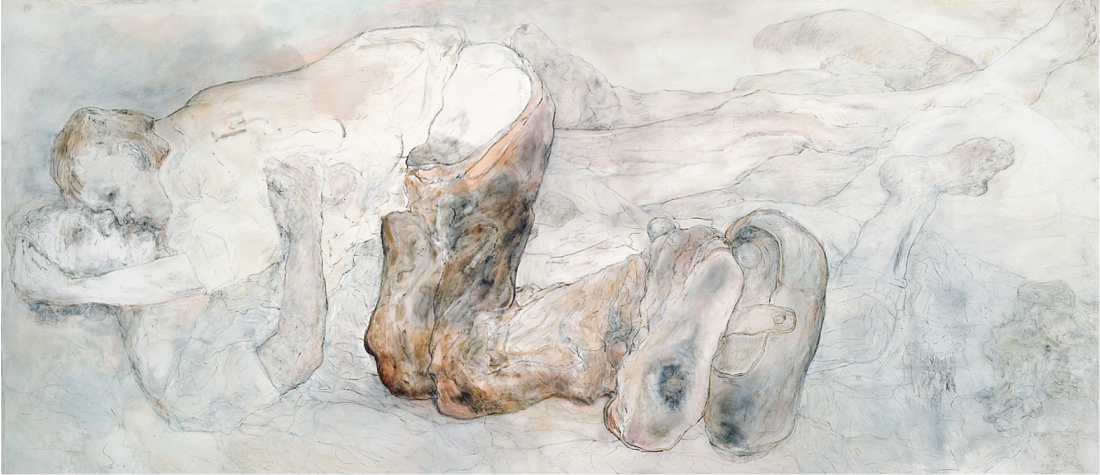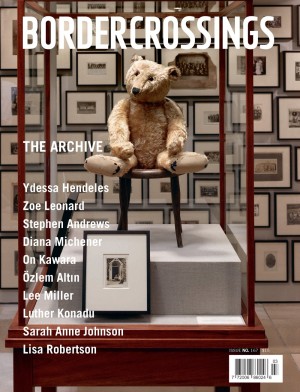Marion Wagschal
This rare, understated yet undeniably replete survey of Marion Wagschal’s works on paper from more than four decades convinces us that she possesses an eye that is at once feral, ferocious and entirely voluptuous.
Her reputation stems from a figurative painting practice that has few parallels in Canada and a teaching practice (now ended) at Concordia University that has influenced scores of young women artists. She has explored the human figure, living and dying, for decades, in painting and drawing, and this exploration has entailed both a harrowing sense of surgical precision in the rendering—and the harrowing up of a sense of our finitude.
When she was younger, she explored Biblical themes with rare abandon, as in her portraits of figures such as Abraham and Isaac, but she was equally given to studying, at the closest quarters, the unbearable minutiae of the quotidian. I mean, the myriad idiosyncrasies, flaws and faults of the lived body in its descent through time. In the beginning and now that body—in both her paintings and the works on paper exhibited here—bears not one iota of false glamour or, rather, it wears the dark glamour of time and its relentless attrition on its sleeve, like so much scar tissue. Her work is unafraid of wrinkles, lesions, rosacea—and she often makes telling references to the Holocaust, Jewish history and her upbringing in Trinidad. I can think of few other artists who have dilated on human damage so rigorously or so well.
The drawings are luminous integers of process. They are also fragmented palimpsests and inordinately suggestive as such. Verisimilitude and violent dissonance enjoy close proximity here. The way that Michel Foucault meant it in his last lectures entitled The Courage to Truth, delivered at the Collège de France, when he claimed that there is no establishment of the truth without an essential position of ‘otherness.’ This has always been axiomatic in Wagschal’s practice. She understands all too well that the truth is never the same. As Foucault held, there can be truth only in the form of the other world and the other life.

Marion Wagschal, 2012, installation view of “Marion Wagschal: Works on Paper/ OEuvres sur papier” at Battat Contemporary, Montreal. Photographs: Elaine Excoffier. Images courtesy the artist and Battat Contemporary.
Above all, Wagschal is a compassionate observer rather than a cruel voyeur. Hers is a species of loving and lucid sight, although she also has that Neue Sachlichkeit legacy. Still, she does not eviscerate, she ‘extracts’—and with fluid, otherworldly skill. The nature of the extraction is based on an intuition so deep and true that it is almost unnatural. You could even say supernatural. It is as though she usually furrows inside her subjects and examines them from the inside out. She is then able to merge inner truth—soul—with outward contour and semblance—skin jacket. This is particularly true of the drawings of her mother on her deathbed.
For Wagschal, if there is a moral, it is this furious and inbred yield-no-quarter truth-telling, whether in the red-veined, ruined portrait of her father, or in the intimate studies of her mother or in her own self-portrait. Her work is ruled by the moral necessity to represent things as they are.
Many of the drawings may be studies en route to painting, but they always undermine their provisional status in relation to it by virtue of their stand-alone character. Seldom pristine, they conjure up in the very draughtsmanship the semblance of truth. Such is the case with Puff, 1976, a nine-foot-high work in mixed media on paper of her brother, which is simply mesmerizing. Her line can be strong and tenuous at one moment and almost invisible, frail and tremulous the next. She draws like an angel and, as Rainer Maria Rilke says, angels are terrifying in their mien.
I remember seeing the portrait of her father (backyard, 1972) in the artist’s basement years ago, where it was languishing, almost lost (moisture had made its way into the matte), and thinking that it was, with all its extravagant lesions and rosacea, radiant in its truthfulness and harrowing in its transmission of a daughter’s autobiographical truth. Viewing a Wagschal is quite nearly a voluptuous experience in its own right.

Marion Wagschal, The Kiss, 2011, mixed media on mylar, 43 x 97”.
Like Lucian Freud, surely a fellow traveller, her development as an artist saw an early obsession with drawing. Freud was dedicated to both drawing and the wide array of works on paper. His relationship to drawing was intimate, and in this not unlike that of Wagschal. In the midst of life, Wagschal finds sure footing as a devotee of extremity and human damage. I have always thought of her as an Ambrose Bierce (the 19th-century American writer and critic) of the drawn and painted image. Her liminal narratives similarly distend time. Indeed, the drawings are full of liminal moments. They are full of secrets that can then become paintings, and it often seems that the moral urgency of her work is impelled by the nearness of death. (Many of her drawings, like those of her dying mother, depict death in process, and then there are the golems and the skulls.) I am quite sure that Wagschal, like Bierce, recognized the lucidity that comes from facing death head on without blinkers. The artist’s preoccupation with life on the threshold is foregrounded here and not exactly latent elsewhere. Bierce was famous for his ‘whiplash endings’ and it speaks to Wagschal’s unblinking, unsparing vision that can raise the hairs on the nape of your neck in one bare instant.
This show at Battat marks only the second time in over two decades that Wagschal has had a solo exhibition of drawings. (The other was held at Concordia’s FOFA gallery under the eagle curatorial eyes of Lynn Beavis and Director Jake Moore not so long ago.) The truth is that she has always drawn, and I have indelibly held in memory many epiphanies from looking at drawings in her studio over long years. Furthermore, an extensive examination of her private journals (of which I have had possibly the unique privilege)—an extraordinarily rich archive of her ideation—shows her working through creative matter in a marvelous, deft, edgy and altogether diverting fashion for the last decades. Her work has all the grim authority of Freud’s dead monkey, but she is also known for the amazing grace of her technical pirouettes. She shares his moral urgency in being Socratically honest with respect to both minutiae and extravagant maximal ‘isness.’
From the early portrait of her father to the deathbed studies of her mother and other works in ink, pencil, conté crayon, watercolour and charcoal, the sheer diversity, eccentricity, unvarnished truth and technical virtuosity of these works make them nothing less than a national treasure. The shame of it is that Marion Wagschal is still the best-kept secret of the Canadian art world. The hatchling joy of it might be that, with shows like this one, the secret may finally be out. ❚
Works on Paper/OEuvres sur papier was exhibited at Battat Contemporary, Montreal, from September 6 to October 20, 2012.
Publication: Marion Wagschal Works on paper, Battat Contemporary, 2012, Montreal, hardcover, 54 pages.
James D Campbell is a writer and curator living in Montreal who contributes regularly to Border Crossings.

